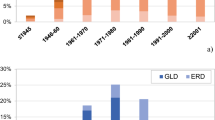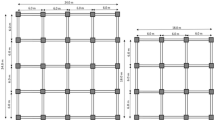Abstract
Seismic fragility curves play a critical role in risk assessment because they represent the probability of attaining different damage states given the ground motion intensity. However, in case of repeated earthquakes, the seismic vulnerability of buildings varies due to damage and this shall be properly considered for the realistic estimate of evolving seismic risk during a seismic sequence. This paper presents a methodology for the assessment of damage-dependent fragility curves for existing reinforced concrete (RC) building classes. The derivation of fragility curves is based on a hybrid method that combines observational based “empirical” curves and mechanical based assessment of buildings’ residual capacity (REC), that is a measure of seismic capacity, which may be reduced due to seismic damage. A mechanism based procedure to assess building REC, and its variation for increasing ductility demand, is presented. Then, in order to be able to apply such procedure to RC building classes, a simulated design procedure is implemented that allows the automatic design of elements dimensions and reinforcement, as well as the characterization of the building nonlinear model needed for mechanism based analysis. Applying a Monte Carlo simulation procedure the geometric, structural and mechanical parameters, from which the design depends on, are varied according to representative distributions and populations of building models are generated and analyzed with mechanism based approach. The procedure is implemented for buildings that are prone to first storey mechanism and is applied for existing RC building classes in L’Aquila.












Similar content being viewed by others
References
ACI 369R–11 (2011) Guide for seismic rehabilitation of existing concrete frame buildings and commentary. Standard by American Concrete Institute, ISBN 978-0-87031:419-3
ASCE-SEI 41–06 (2007) Seismic rehabilitation of existing buildings, ASCE standard. American Society of Civil Engineers, Reston, VA
Baggio C, Bernardini A, Colozza R, Di Pasquale G, Dolce M, Goretti A, Martinelli A, Orsini G, Papa F, Zuccaro G, Pinto AV, Taucer F, EUR 22868 EN (2007) Field manual for post-earthquake damage and safety assessment and short term countermeasures (AeDES). Joint Research Center, Ispra, Italy
Bazzurro P, Cornell CA, Menun C, Motahari M (2004) Guidelines for seismic assessment of damaged buildings. In: 13th World conference on earthquake engineering. Vancouver, BC, Canada, Paper No. 1708
Borzi B, Pinho R, Crowley H (2008) Simplified pushover-based vulnerability analysis for large scale assessment of RC buildings. Eng Struct 30(3):804–820
Braga F, Dolce M, Liberatore D (1982) A statistical study on damaged buildings and an ensuing review of the MSK-76 scale. In: Proceedings of the seventh European conference on earthquake engineering, Athens, Greece, pp 431–450
Calvi GM (1999) A displacement based approach for vulnerability evaluation of classes of buildings. J Earthq Eng 3(3):411–438
Celarec D, Vamvatsikos D, Dolšek M (2011) Simplified estimation of seismic risk for reinforced concrete buildings with consideration of corrosion over time. Bull Earthq Eng 9:1137–1155
Cosenza E, Manfredi G, Polese M, Verderame GM (2005) A multilevel approach to the capacity assessment of RC buildings. J Earthq Eng 9(1):1–22
Di Ludovico M, Polese M, Prota A, Manfredi G (2013) A proposal for plastic hinges modification factors for damaged RC columns. Eng Struct 51:99–112
Di Pasquale G, Orsini G, Romeo RW (2005) New developments in seismic risk assessment in Italy. Bull Earthq Eng 3(1):101–128
Dolšek M, Fajfar P (2004) IN2: a simple alternative for IDA. In: 13th World conference on earthquake engineering. Vancouver, BC, Canada, 2004; Paper No. 3353
Ebrahimian H, Jalayer F, Asprone D, Lombardi AM, Marzocchi W, Prota A, Manfredi G (2013) An outlook into time-dependent aftershock vulnerability assessment. In: Papadrakakis M, Papadopoulos V, Plevris V (eds) 4th ECCOMAS thematic conference on computational methods in structural dynamics and earthquake engineering (COMPDYN2013). Kos Island, Greece
Elwood KJ, Eberhard MO (2009) Effective stiffness of reinforced concrete columns. ACI Struct J Am Concret Inst 106(4):476–484
FEMA 306 (1998) Evaluation of earthquake damaged concrete and masonry wall buildings: basic procedures manual. Federal Emergency Management Agency, Washington, DC
Faccioli E, Cauzzi C (2006) Macroseismic intensities for seismic scenarios estimated from instrumentally based correlations. In: Proceedings of the first European conference on earthquake engineering and seismology (a joint event of the 13th ECEE & 30th General Assembly of the ESC) Ginevra, 3–8 Settembre 2006, CD-ROM
Faenza L, Michelini A (2010) Regression analysis of MCS intensity and ground motion parameters in Italy and its application in ShakeMap. Geophys J Int 180:1138–1152
Fajfar P (1999) Capacity spectrum method based on inelastic demand spectra. Earthq Eng Struct Dyn 28:979–993
Ghosh J, Padgett JE (2010) Aging considerations in the development of time-dependent seismic fragility curves. J Struct Eng ASCE 136:1497–1511
Giovinazzi S, Lagomarsino S (2004) A macroseismic method for the vulnerability assessment of buildings. In: Proceedings of the 13th World conference on earthquake engineering, Vancouver, Canada, Paper No. 896 (on CD)
Goretti A, Bramerini F, Di Pasquale G, Dolce M et al (2008) The Italian contribution to the USGS PAGER project. In: 14th World conference on earthquake engineering, Beijing, China
Grunthal G (1998) European macroseismic scale. Chaiers du Centre Européen de Géodynamique et de Séismologie, vol 15, Luxembourg
Guagenti E, Petrini V (1989) Il caso delle vecchie costruzioni: verso una nuova legge danni-intensità. In: Proceedings of the 4th Italian national conference on earthquake engineering, Milan, Italy, vol 1, pp 145–153
ISTAT—Istituto Nazionale di Statistica (2001) National census data. http://www.istat.it
Jalayer F, Asprone D, Prota A, Manfredi G (2011) A decision support system for post-earthquake reliability assessment of structures subjected to after-shocks: an application to L’Aquila earthquake, 2009. Bull Earthq Eng 9(4):997–1014
Kilar V, Fajfar P (1997) Simple push-over analysis of asymmetric buildings. Earthq Eng Struct Dyn 26:233–249
Lagomarsino S, Giovinazzi S (2006) Macroseismic and mechanical models for the vulnerability and damage assessment of current buildings. Bull Earthq Eng 4:415–443
Liel AB, Lynch KP (2012) Vulnerability of reinforced-concrete-frame buildings and their occupants in the 2009 L’Aquila, Italy, Earthquake. Nat Hazards Rev 13(1):11–23
Maffei J, Telleen K, Mohr D, Holmes W (2006) Test applications of advanced seismic assessment guidelines. PEER Report 2005/09, Pacific Earthquake Engineering Research Center. University of California, Berkeley
Margottini C, Molin D, Serva L (1992) Intensity versus ground motion: a new approach using Italian data. Eng Geol 33(1):45–58
Marzocchi W, Lombardi AM (2009) Real-time forecasting following a damaging 740 earthquake. Geophys Res Lett 36:L21302. doi:10.1029/2009GL040233
Masi A (2003) Seismic vulnerability assessment of gravity load designed R/C frames. Bull Earthq Eng 1:371–395
NNT (2008) Ministerial Decree D.M. 14.01.2008 New Technical Standards for Construction (In Italian)
Mazzolani FM, Piluso V (1997) Plastic design of seismic resistant steel frames. Earthq Eng Struct Dyn 26:167–191
Pagni CA, Lowes LN (2006) Fragility functions for older reinforced concrete beam–column joints. Earthq Spectr 22(1):215–238
Polese M, Di Ludovico M, Prota A, Manfredi G (2013a) Damage-dependent vulnerability curves for existing buildings. Earthq Eng Struct Dyn 42(6):853–870
Polese M, Marcolini M, Prota A, Zuccaro G (2013b) Mechanism based assessment of damaged building’s residual capacity. In: 4th ECCOMAS thematic conference on computational methods in structural dynamics and earthquake engineering (COMPDYN2013), Kos Island, Greece, Paper No. 1524
Polese M, Verderame GM, Manfredi G (2011) Static vulnerability of existing R.C. buildings in Italy: a case study. Struct Eng Mech 39(4):599–620
Rahunandan M, Liel AB, Ryu H, Luco N, Uma SR (2012) Aftershock fragility curves and tagging assessments for a mainshock-damaged building. In: Proceedings of the 15th WCEE, Lisboa, Portugal Paper No. 1708, pp 24–28
Réveillère A, Gehl P, Seiedi D, Modaressi H (2012) Development of seismic fragility curves for mainshock-damaged reinforced–concrete structures. In: Proceedings of the 15th WCEE Lisboa, Portugal, Paper No. 1708, pp 24–28
Ricci P, De Luca F, Verderame GM (2011) 6th April 2009 L’Aquila earthquake, Italy: reinforced conceret building performance. Bull Earthq Eng 9:285–305
Rossetto T, Elnashai A (2003) Derivation of vulnerability functions for European-type RC structures based on observational data. Eng Struct 25:1241–1263
Rossetto T, Peiris N, Alarcon JE, So E, Sargeant S, Free M, Sword-Daniels V, Del Re D, Libberton C, Verrucci E, Sammonds P (2011) Field observations from the Aquila, Italy earthquake of April 6, 2009. Bull Earthq Eng 9:11–37
Sanchez-Silva M, Klutke GA, Rosowsky DV (2011) Life-cycle performance of structures subject to multiple deterioration mechanisms. Struct Saf 33(3):206–217
Sucuoğlu H, Yazgan U, Yakut A (2007) A screening procedure for seismic risk assessment in urban building stocks. Earthq Spectr 23(2):441–458
Verderame GM, Manfredi G, Frunzio G (2001) Le proprietà meccaniche dei calcestruzzi acciai impiegati nelle strutture in cemento armato realizzate negli anni ’60. Atti dell’10\(^{\circ }\) Convegno Nazionale Anidis - L’ingegneria Sismica in Italia, Potenza-Matera (in Italian)
Verderame GM, Polese M, Mariniello C, Manfredi G (2010) A simulated design procedure for the assessment of seismic capacity of existing reinforced concrete buildings. Adv Eng Softw 41:323–335
Verderame GM, Ricci P, Esposito M, Manfredi G (2012a) STIL v1.0, Software and Handbook. http://www.reluis.it/index.php?option=com_content&view=article&id=199&Itemid=136&lang=it
Verderame G M, De Luca F, De Risi M T, Del Gaudio C, Ricci P (2012b) A three level vulnerability approach for damage assessment of infilled RC buildings: the Emilia 2012 case (V 1.0). http://www.reluis.it
Verderame GM, Polese M, Cosenza E (2009) Vulnerability of existing R.C. buildings under gravity loads: a simplified approach for non sway structures. Eng Struct 31(9):2141–2151
Vidic T, Fajfar P, Fischinger M (1994) Consistent inelastic design spectra: strength and displacement. Earthq Eng Struct Dyn 23:507–521
Zuccaro G, Albanese V, Cacace F, Mercuri C, Papa F et al (2008) Seismic vulnerability evaluations within the structural and functional survey activities of The COM bases. In: Italy, AIP conference proceedings, paper ID 1020, pp 1665–1674. doi:10.1063/1.2963797
Acknowledgments
This study was performed in the framework of EU CRISMA Project. CRISMA is funded from the European Community’s Seventh Framework Programme FP7/2007-2013 under Grant agreement No. 284552.
Author information
Authors and Affiliations
Corresponding author
Rights and permissions
About this article
Cite this article
Polese, M., Marcolini, M., Zuccaro, G. et al. Mechanism based assessment of damage-dependent fragility curves for RC building classes. Bull Earthquake Eng 13, 1323–1345 (2015). https://doi.org/10.1007/s10518-014-9663-4
Received:
Accepted:
Published:
Issue Date:
DOI: https://doi.org/10.1007/s10518-014-9663-4




